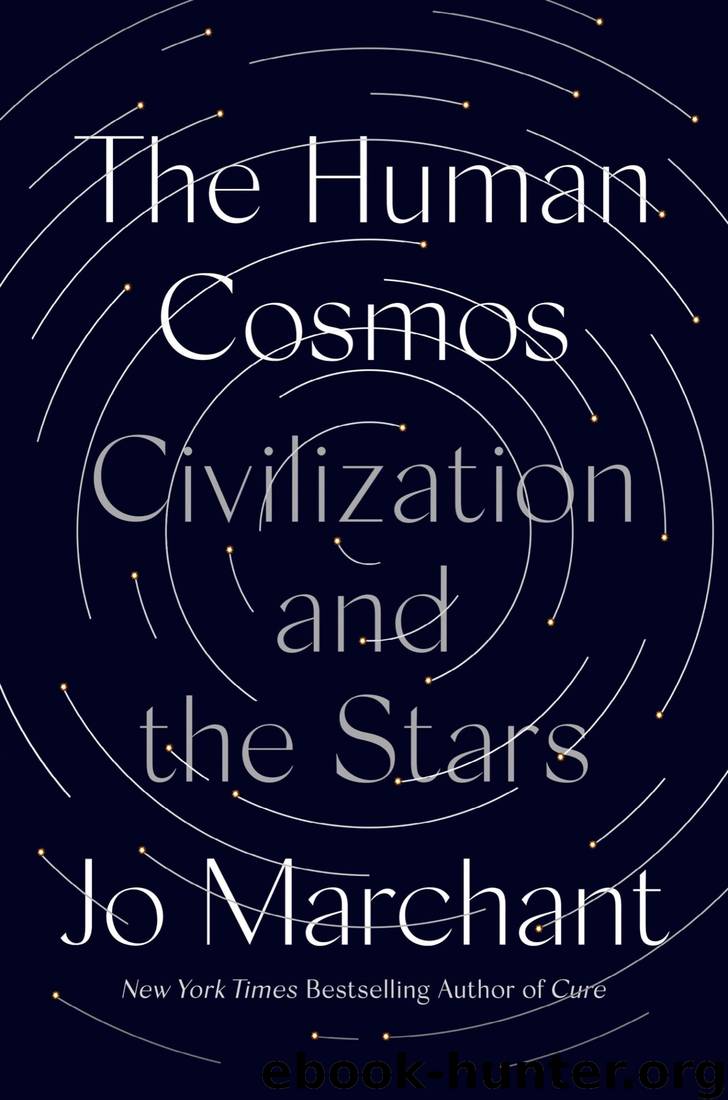The Human Cosmos: Civilization and the Stars by Jo Marchant

Author:Jo Marchant
Language: eng
Format: epub
Publisher: Dutton
Published: 2020-09-01T23:00:00+00:00
* * *
Once he scaled the heights of Suprematism, Malevich didn’t pursue his wooden-spoon attacks on reason. But other artists did subsequently build careers out of attacking humanity’s norms and rules. One was Marcel Duchamp (famous for presenting a urinal as a work of art in 1917), who tirelessly targeted scientists’ view of the cosmos, and said he wanted “to strain the laws of physics.” In 1914, he cut wooden slats according to a 3-foot-long string that he dropped three times, creating “a new standard of measurement based on chance.” In 1921, he shaved his hair into the shape of a comet, tracing his own erratic orbit on the streets of Paris.
Duchamp’s work helped to inspire surrealism, one of the twentieth century’s major art movements, which embraced the irrational and absurd. Positivism was stifling intellectual and moral advancement, complained poet André Breton, one of surrealism’s founders, in 1924: “Experience . . . paces back and forth in a cage from which it is more and more difficult to make it emerge.” Surrealists aimed to use the unconscious mind, as well as chance, to free the imagination and escape the restrictions and conventions of rational thought.
Even so, they couldn’t help but respond to the latest advances in science. In the first literary expression of surrealism, Breton cowrote an extraordinary book called Les Champs Magnétiques (The Magnetic Fields). It aimed to capture the dreamy, unfiltered voice of the unconscious mind, and was packed with bizarre settings and clashing images. In one passage, “the smart set” journeys to find “buried suns” in a distant place where “on blood-stained shingly beaches one may hear the tender murmur of the stars.” The section is called Eclipses, and it was written just as British astronomers traveled to Sobral in Brazil, and the island of Principe, West Africa, to observe a real-life solar eclipse predicted for May 29, 1919. Their mission was to measure the deflection of starlight during the eclipse, a problem that lead scientist Arthur Eddington described as “weighing light.” No wonder surrealist Breton was fascinated. Now it was the scientists’ turn to leave behind the comforts of common sense, and journey into territory that was strange beyond their wildest dreams.
Classical physics describes a universe in which objects exist and events occur within a fixed, absolute grid of time and space. It’s an approach that was highly successful for describing everyday events on Earth; by the end of the nineteenth century some physicists thought there was little left to discover. Then Albert Einstein, working in the Swiss patent office in Bern, asked himself what would happen if you could travel at light speed in such a universe, and concluded that for such an observer, light beams traveling in the same direction would appear to stop. Yet according to Maxwell’s rock-solid equations describing electromagnetism, that was impossible; light always travels at the same speed.
So Einstein assumed instead that the speed of light must stay the same for everyone, regardless of how fast an observer moves, and reached a mind-boggling conclusion: that space and time change depending on your point of view.
Download
This site does not store any files on its server. We only index and link to content provided by other sites. Please contact the content providers to delete copyright contents if any and email us, we'll remove relevant links or contents immediately.
Tools of Titans by Timothy Ferriss(7810)
Turbulence by E. J. Noyes(7700)
Astrophysics for People in a Hurry by Neil DeGrasse Tyson(5000)
Secrets of Antigravity Propulsion: Tesla, UFOs, and Classified Aerospace Technology by Ph.D. Paul A. Laviolette(4989)
Design of Trajectory Optimization Approach for Space Maneuver Vehicle Skip Entry Problems by Runqi Chai & Al Savvaris & Antonios Tsourdos & Senchun Chai(4839)
Room 212 by Kate Stewart(4732)
Pale Blue Dot by Carl Sagan(4613)
The David Icke Guide to the Global Conspiracy (and how to end it) by David Icke(4377)
A Journey Through Divination and Astronomy by Publishing Pottermore(4248)
Apollo 8 by Jeffrey Kluger(3512)
Goodbye Paradise(3444)
Losing the Nobel Prize by Brian Keating(3425)
COSMOS by Carl Sagan(3346)
The Five People You Meet in Heaven by Mitch Albom(3334)
How to Read Water: Clues and Patterns from Puddles to the Sea (Natural Navigation) by Tristan Gooley(3239)
Brief Answers to the Big Questions by Stephen Hawking(3239)
How to Read Nature by Tristan Gooley(3077)
The Order of Time by Carlo Rovelli(3073)
A Brief History of Time by Stephen Hawking(2819)
